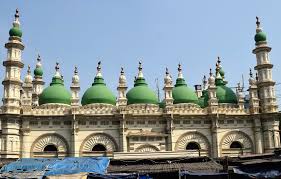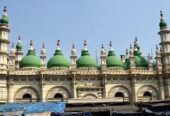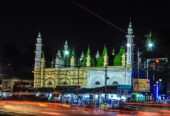Tipu Sultan Mosque: A Majestic Symbol of Faith and History in Kolkata
The Tipu Sultan Mosque, located in the bustling heart of Kolkata, is a splendid testament to the city’s rich cultural and religious heritage. This historic mosque, built by the youngest son of Tipu Sultan, the famed ruler of Mysore, stands as a symbol of Islamic architecture and community spirit. It is not only a place of worship but also an architectural marvel that attracts visitors from all walks of life.
Historical Background
The Tipu Sultan Mosque, also known as the Tipu Sultan Shahi Masjid, was commissioned by Prince Ghulam Mohammed in 1832. Prince Ghulam Mohammed was the youngest son of Tipu Sultan, who valiantly fought against the British East India Company during the late 18th century. After the fall of Seringapatam in 1799 and the death of Tipu Sultan, his family was exiled to Calcutta (now Kolkata). The mosque was built to serve the religious needs of the Muslim community and as a tribute to Tipu Sultan’s legacy.
Architectural Features
- Mughal Style Architecture: The Tipu Sultan Mosque is an exquisite example of Mughal architectural style, characterized by its intricate designs and grandiose structures. The mosque’s architecture reflects the grandeur and elegance associated with Mughal-era buildings.
- Domes and Minarets: The mosque features multiple domes and minarets, which are quintessential elements of Islamic architecture. The central dome is flanked by smaller domes, while the towering minarets add to the mosque’s majestic appearance.
- Intricate Carvings: The exterior and interior walls of the mosque are adorned with intricate carvings and calligraphy. The detailed designs include floral motifs, geometric patterns, and inscriptions from the Quran, showcasing the artistry and craftsmanship of the era.
- Prayer Hall: The spacious prayer hall of the mosque can accommodate a large number of worshippers. The hall is designed to provide a serene and tranquil environment for prayer and reflection, with its high ceilings and elegant arches.
- Courtyard: The mosque features a large courtyard that serves as a gathering place for worshippers. The courtyard’s open space is surrounded by arched walkways and lush greenery, enhancing the overall aesthetic appeal of the mosque.
Cultural and Religious Significance
- Place of Worship: The Tipu Sultan Mosque is an active place of worship, serving the religious needs of Kolkata’s Muslim community. Daily prayers, Friday congregational prayers, and special religious events are held at the mosque, fostering a sense of community and spiritual connection.
- Historical Landmark: As a historical landmark, the mosque stands as a reminder of Tipu Sultan’s legacy and the rich history of Kolkata’s Muslim population. It is a symbol of resistance against colonial rule and the enduring spirit of faith and resilience.
- Community Hub: The mosque plays a vital role in the social and cultural life of the community. It hosts various religious and cultural events, including Islamic festivals, educational programs, and charitable activities, promoting social cohesion and mutual support.
- Architectural Heritage: The mosque’s architectural splendor attracts tourists, historians, and architecture enthusiasts. It serves as an important example of Mughal-inspired Islamic architecture in Kolkata and contributes to the city’s diverse cultural heritage.
Visitor Experience
- Guided Tours: Visitors to the Tipu Sultan Mosque can take guided tours to learn about its history, architecture, and cultural significance. These tours provide valuable insights into the mosque’s heritage and its role in the community.
- Prayer Services: Non-Muslim visitors are welcome to observe the prayer services, provided they respect the mosque’s customs and dress code. Witnessing the prayers offers a deeper understanding of Islamic worship practices.
- Architectural Appreciation: The mosque’s intricate designs and beautiful architecture are a treat for the eyes. Visitors can spend time exploring the detailed carvings, domes, and minarets, capturing the essence of Mughal artistry.
- Cultural Immersion: Engaging with the local community and participating in cultural events at the mosque allows visitors to experience the rich traditions and hospitality of Kolkata’s Muslim population.
Accessibility and Visitor Information
- Location: The Tipu Sultan Mosque is located at 185, Dharmatala Street, near Esplanade, Kolkata, West Bengal, India.
- Visiting Hours: The mosque is open to visitors throughout the day. It is advisable to visit during non-prayer times to avoid disruption of religious activities.
- Entry Fee: There is no entry fee to visit the mosque. However, donations for the upkeep and maintenance of the mosque are appreciated.
- Dress Code: Visitors are expected to dress modestly and remove their shoes before entering the mosque. Women are advised to cover their heads as a mark of respect.
- Accommodation: Various accommodation options are available near the mosque, ranging from budget hotels to luxury lodges. Visitors can choose based on their preferences and convenience.
Conclusion
The Tipu Sultan Mosque stands as a magnificent symbol of Kolkata’s rich cultural tapestry and religious harmony. Its architectural grandeur, historical significance, and role as a vibrant community hub make it a must-visit destination for anyone interested in exploring the city’s heritage. Whether you are a history enthusiast, an architecture lover, or a spiritual seeker, a visit to the Tipu Sultan Mosque promises a deeply enriching and memorable experience









Leave feedback about this